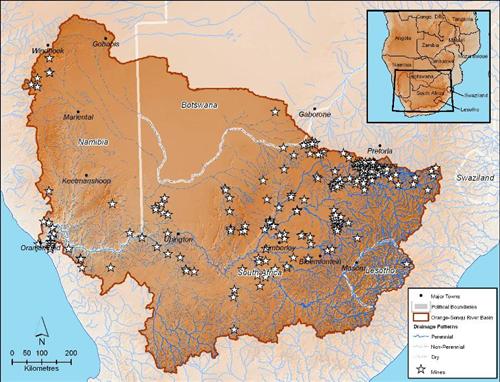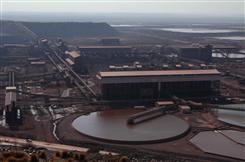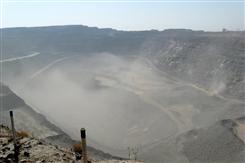Areas where mineral resources exist and the mining of these has been economically analysed are called mineral reserves. The defining factor in identifying an area as a mineral reserve is whether after all mining factors(including processing,cost of diluting materials etc ) have been applied, it remains economically viable to mine it.
Mineral extraction and processing play important parts in the economy of the southern African region. The presence and extraction of precious and non-precious metals and gemstones have driven development in the SADC region for centuries, with positive and negative outcomes in social,cultural and environmental terms.
The region, including the four basin states of the Orange Senqu basin is endowed with a rich variety of mineral resources most of which are economically mineable and are being extracted. Several others have been identified as probable mineral reserves.
Mining in the Orange-Senqu River basin is well developed and contributes significantly to the economies of Botswana, Namibia and South Africa. The predominant minerals found in the basin include gold,diamonds, uranium, base metals (copper, manganese and iron), semi-precious stones and industrial minerals. Gold, diamonds, uranium and coal mining are of particular economic importance, but the extraction and processing of these minerals have implications in terms of water quality impacts.
Although mines use relatively small amounts of water compared to agriculture, water supplies must be reliable due to the large costs associated with disruption to extraction and processing. This increases water consumption by this sector.
The map below illustrates the distribution of mines as an indication of the active mineral reserves in the basin.

The distribution of mines across the Orange-Senqu River basin.
Source:Hatfield 2009, after UNDP 2008
( click to enlarge )
Mining in the Orange-Senqu River Basin Member States
-
Botswana has been named the world's largest diamond producer in 2010, with diamond mining accounting for 70% of export earnings in the country.Mining contributes at least 35 % of the GDP in Botswana with Copper, soda-ash, nickel amongst other important commodities mined (Ashton et al. 2000).Despite this, the physical characteristics (geology) of the country present still present a challenge in exploring all available mineral reserves. Several mineral resources including asbestos,chromite,managnese located in remote areas remain unexploited(Newman 2010).The latest data on mineral reserves dating as far back a 1999 indicates that soeme proven coal reserves have successfully been mined over the last decade( DEA 2007).
-
In Lesotho, mining is not a dominant contributor to the economy, accounting for less than 1 % of the GDP.
-
Namibia is one of the world's largest diamond producers and uranium exporters. Although uranium is not produced within the Orange-Senqu River Basin, a majority of diamond mines are located in the basin. The mining sector only employs 3 % of the population, but it accounts for over 9% of the GDP, and generates more than 50 % of foreign exchange earnings in Namibia.
-
In South Africa, mining accounts for 7 % of the GDP. Despite being overtaken by China as the worlds largest producer of gold South Africa reamins a major player in the Gold mining industry. it is also a leading producer and exporter of various metals including antimony, chromites, fluorite, gems and industrial diamonds, manganese, platinum, vanadium, and vermiculite.
 Sishen Iron Ore Mine, Northern Cape, South Africa. Source:Vogel 2009 ( click to enlarge ) |
 Debswana's Jwaneng Diamond Mine, Kwaneng District, Botswana. Source:Cretep 2007 ( click to enlarge ) |
